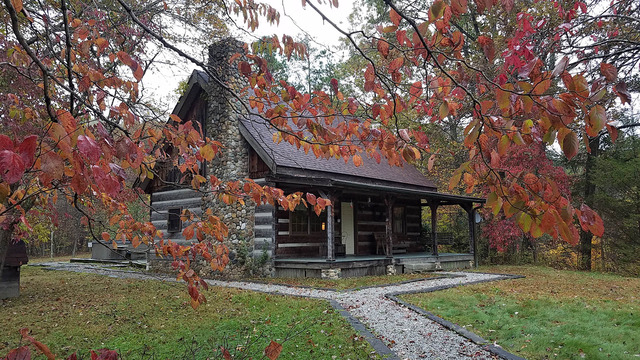FORKED RUN STATE PARK
Forested hills, a picturesque lake and the lazy Ohio River characterize Forked Run State Park. Located in the heart of Appalachia, colorful history, riverboats,scenic vistas and abundant wildlife give the park its rural charm.
Forked Run State Park lies in the forested hill country of southeastern Ohio. This is Ohio's oldest landscape never reached by the glacial ice that once covered much of Ohio. Although this area was untouched by the massive ice sheets, torrents of glacial meltwaters hastened the carving of the valleys and hillsides into their present-day form.
Much of the area, now heavily forested, was once void of timber. Trees were cut to fuel the many iron furnaces of the area in the mid 1800s. Today, much of the forest has regrown, and vast stands of oak, hickory, maple and tuliptree clothe the deep ravines and hillsides. Wildflowers can be found in bloom except in winter months. Wild blue phlox, bloodroot, dame's rocket, cardinal flower, daisy fleabane, goldenrod and asters provide colorful displays. In spring, the hillsides burst forth with brilliant blooms of dogwood and redbud.
The forest and fields provide habitat for a variety of wildlife species including gray fox, raccoon, opossum, gray squirrel, white-tailed deer and wild turkey. Many songbirds enjoy the refuge of the forest including wood thrush,white-breasted nuthatch, scarlet tanager, pileated woodpecker and whip-poor-wills.
The colorful history and folklore of the Ohio River create the character of Forked Run State Park. The Ohio River felt the pull of the Indian's paddle, served as a territorial boundary, brought settlers into the Northwest Territory and carried flatboats and steamers that shipped passengers and cargo from Pittsburgh to New Orleans.
The mouth of the Shade River which empties into the Ohio nearby was known as a gloomy, rocky place called the Devil's Hole. The Native Americans returning from their raids into western Virginia routinely crossed the Ohio at that point. They would travel through the valley of the Shade River on the way to their towns on the Scioto. Settlement of the area was slow to develop until the Native Americans had subsided and the discovery of coal in the region provided means of support.
As mining increased, towns sprang up along the Ohio. Pomeroy, Middleport, Minersville and Syracuse were important mining centers. The coal was used to manufacture coke which in turn was used in the many furnaces that smelted iron ore from the surrounding sandstone bedrock. The ore resulted in iron used to produce agricultural implements, ammunition and cannons for the Union Army during the Civil War. During the 1860s, Ohio was one of the nation's leading producers of iron.
Equally important to the prosperity of the area was the salt industry. The first salt well was drilled in 1850 near Pomeroy. Eighteen salt furnaces were in operation during their peak of importance. Nearly 3,600 barrels of salt were produced daily.
The villages of Reedsville and Belleville were important boat-building centers, and it was on this section of the Ohio River that Captain Horatio Crooks introduced the compound-cylinder steam engine.
John Hunt Morgan, the Confederate General, while on his raid through Ohio was hampered in his efforts here to escape into western Virginia. The local militia thwarted Morgan's effort to ford the Ohio near Pomeroy, and as a result, he was eventually captured in Columbiana County.
Today, the area is known as a truck-farming center which produces crops of cabbage, melons, sweet corn and the famous Ohio River tomatoes.
Construction of Forked Run State Park began in May of 1951. In October 1952, the 102-acre lake was completed. The lake was stocked and opened to the public in the following year.
Ohio does not have an annual pass and does not charge entrance fees to state parks.
GeneralLand, acres815
Water, acres102
Nearby State Forest, acres2,601
Day-UseFishingyes
Huntingyes
Hiking Trail, miles4
Picnickingyes
Picnic Shelters, #2
Swimming Beach, feet400
Nature Programsyes
BoatingBoat Rentalyes
Boating Limits10
Seasonal Dock Rental5
Launch Ramps, #3
CampingPrimitive, #64
Electric Sites, #81
Pets Permittedyes
Dumpstationyes
Showersyes
Rent-A-Camp Sites, #3
Camper Cabins, #3
Group Camp, capacity25
WinterSleddingyes
The main campground is situated on the ridges overlooking the scenic valley of Forked Run Lake. There are 198 non-electric sites in both sunny and shady areas. The campground offers showers, pet camping sites and a dump station. A group camp that can accommodate 120 individuals is available by reservation. Three Rent-A-Camp units consisting of a tent, dining fly, cooler, cookstove and other equipment can be rented during summer months by reservation. Three camper cabins are available for nightly rental.



